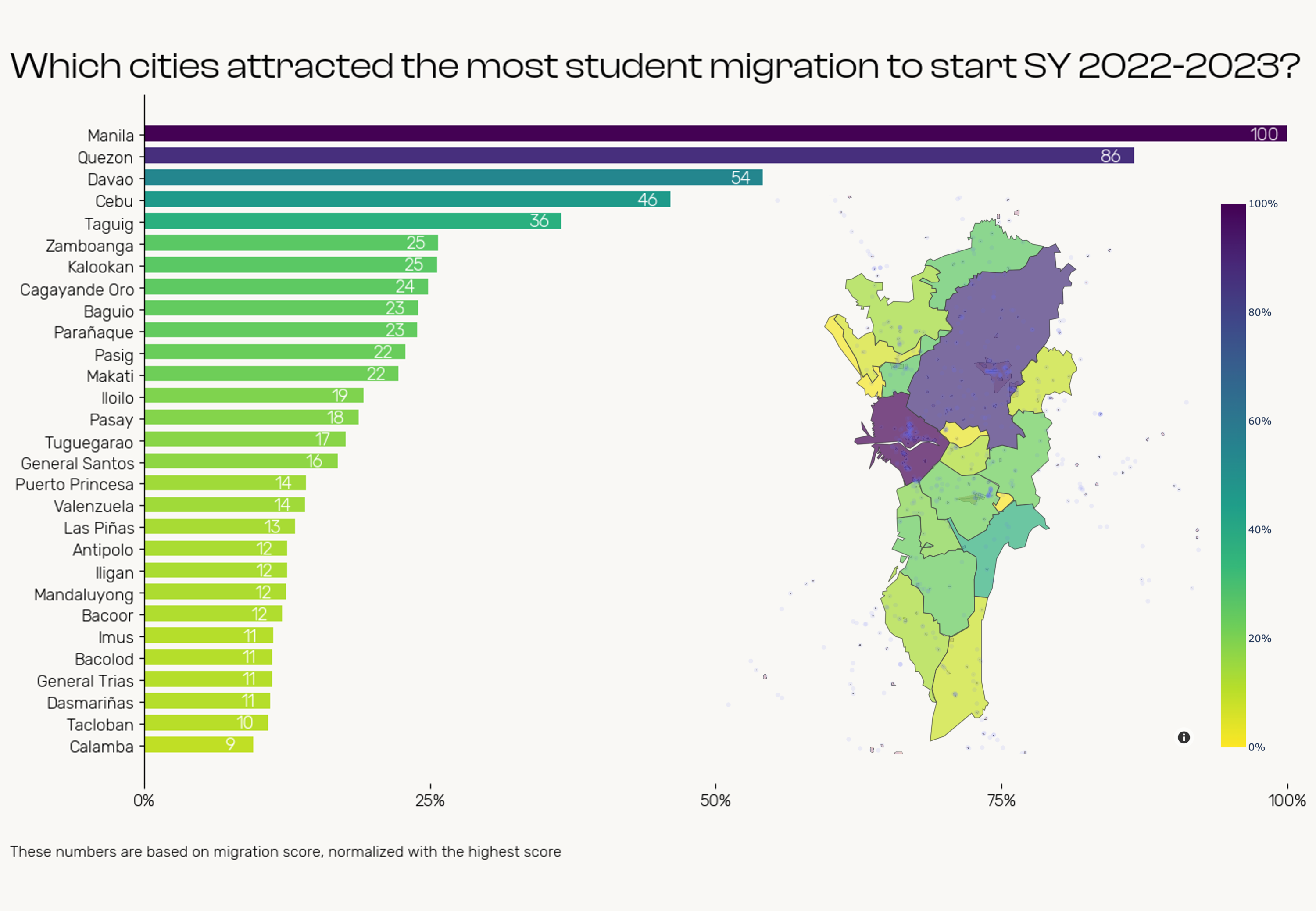Uncharted | Student migration
Our domestic travel report for 2022 showed that the highest migration season occurs between May-June and Aug-Sept. This easily lines up with the start and end of the school year respectively – which begs the questions on where do students migrate to? How far are they willing to travel to pursue higher education?
In this entry to our Uncharted series, we will attempt to answer these questions, and so much more.
Baguio City
Baguio City has three main universities that belong to the top 100 QS world ranking in the Philippines for 2023. With this, and given the great living conditions in the city, it has consistently attracted students and tourists alike. Many universities have tried different measures to limit the volume of students that flock its campuses every year. Saint Louis University (SLU) had almost 20 thousand enrollees in 2019, according to the Commission on Higher Education’s Statistical Data. Meanwhile, University of the Philippines Baguio has had similar over-enrollment issue – with an attempt to relocate its campus to Tuba town, Benguet province in the 1990s but was unsuccessful.
Bauko, Mountain Province
Students from Bauko, Mountain Province are the 2nd most willing to travel and stay in Baguio in the months of August and September 2022. Despite being 66 km from Baguio City, students travel to Baguio City at the start of the school year. There are several factors for this. Mainly, we think that the absence of highly ranked educational institutions in the surrounding Mountain Province area pushes students to look elsewhere to pursue their education.
This is the same reason why most of the migrating cities/municipalities come from the north of Baguio City around the Mountain Province.
Itogon, Mountain Province
Itogon had the highest student migration share to Baguio City at 12.5%. It is surprising that students have to move to the city to study given that it is just next to Baguio. The average distance between the city centers is 14km so either we are underestimating the distance, or there are not enough travel options for students to stay in Itogon while studying in Baguio.
This trend is also true for the 3rd place which is Tuba, another city adjacent to Baguio.
La Trinidad
We want to compare the migration to Baguio City in the same succeeding months to another university hub nearby and we went for La Trinidad – which is another 1st class city adjacent to Baguio City. La Trinidad’s main university, Benguet State University (main campus) ranks 40th in the latest Edurank for universities in the Philippines.
Similar to Baguio City, most if not all migrating cities/municipalities come from the north of La Trinidad. Unlike Baguio City, the majority of the top migrators to La Trinidad are closer to the city. For Baguio City, Bauko was the top migrating municipality at 66 km away. For La Trinidad, the top migrating municipality is Buguias, Benguet which is around 40 km from La Trinidad.
Take away insights
- Most of migrating municipalities are located in the northern part of Luzon. The preliminary hypothesis is the availability (or lack) of competent universities in the northeast of Luzon. Most students in that area are willing to migrate around Baguio and La Trinidad to study.
- Baguio has farther reach of municipalities with students willing to migrate. La Trinidad receives students often from relatively nearby areas.
This pattern gave us the idea to create a ‘Migration Score’.
Calculating migration score
We will define migration score as the quantity that reflects the affinity of a place for people to migrate to it despite the distance. A higher migration score means more people are willing to travel to a particular place regardless of the travel cost to them.
We can use a rudimentary method to calculate the migration score. The score will only take into account the percentage of people (in our case students), travelling to our municipality/city and the distance between the receiving and the source area. We will call this the migration factor for each source municipality, while the sum of all migration factors from all the sources of migration will be the migration score. This score won’t take into consideration the ease of travel (availability of transportation, or terrain like crossing seas) or other factors.
Since Baguio City has more willing migrators from farther places, we expect it to have a higher migration score than La Trinidad.
Migration score results
At 46,275 points, Baguio City has around eight times the migration score of La Trinidad at around 5,994. Bauko, Mountain Province had the highest migration factor for Baguio City at 823 points given as it is around 66 km away from Baguio City. For La Trinidad, the highest contributor to its migration score is Buguias, Benguet with 23.9% of its student population having to travel to the city at 40 km away.
Migration score of cities/municipalities
We mapped out the migration score of every city and municipality in the Philippines.

As expected, the capital city Manila had the highest migration score of all cities and municipalities we compared. Quezon and Davao came 2nd and third boasting 86% and 54% the migration affinity for Manila. Both cities containing premier universities such as UP Diliman and Mindanao, Ateneo de Manila and Ateneo de Davao University.
What’s surprising is Tuguegarao, General Santos, Puerto Princesa, etc placing highly on this list, given that they are not known for their universities. Looking at the map, we can speculate that the unavailability of competent schools near these areas plays a big factor in the migration behavior of students. If we focus on Puerto Princesa, the island nature of Palawan limits opportunities of students (especially for poorer students) to migrate to other areas if they do decide to travel. They then tend to settle in the capital to pursue college education.
Baguio City and La Trinidad are 9th and 76th on the migration score ranking respectively.
We will do a separate and deeper investigation of student migration on our future contents so stay tuned. We will explore other places and add more metrics to quantify our observations.
Availability of Tertiary education
Hopefully, this article was able to shed some light on the current education situation in the country. The lack of schools forces students to travel, migrate, and leave their families behind to pursue higher education. Fortunately, if we assume university rankings as complete reflection of quality of education, we can say that some schools are improving in providing better services to our youth.
As our cities develop, the government and private institutions need to provide enough support to build better educational hubs to incentivize the next generation of learners to stay with their communities. This way, they are more likely to participate in the development of their community – which on a bigger picture will help decongest the metros, accelerate domestic development especially in remote areas, and provide access to education to more and more Filipinos.
Want to learn more about our products? Get in touch with us today and let’s see what we can discover together. Email us at info@inquiro.ph.



